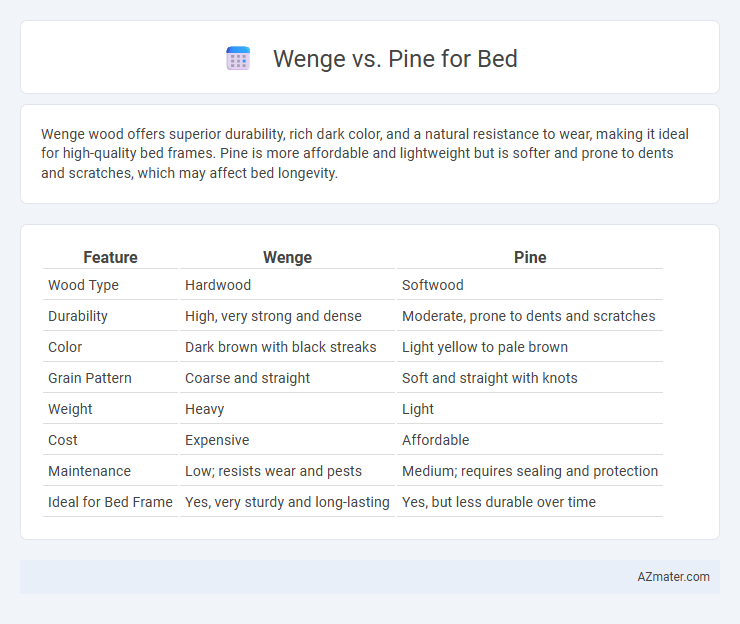Wenge wood offers superior durability, rich dark color, and a natural resistance to wear, making it ideal for high-quality bed frames. Pine is more affordable and lightweight but is softer and prone to dents and scratches, which may affect bed longevity.
Table of Comparison
| Feature | Wenge | Pine |
|---|---|---|
| Wood Type | Hardwood | Softwood |
| Durability | High, very strong and dense | Moderate, prone to dents and scratches |
| Color | Dark brown with black streaks | Light yellow to pale brown |
| Grain Pattern | Coarse and straight | Soft and straight with knots |
| Weight | Heavy | Light |
| Cost | Expensive | Affordable |
| Maintenance | Low; resists wear and pests | Medium; requires sealing and protection |
| Ideal for Bed Frame | Yes, very sturdy and long-lasting | Yes, but less durable over time |
Overview: Wenge vs Pine Wood for Beds
Wenge wood offers exceptional durability and a deep, rich brown color with a unique grain pattern, making it ideal for luxurious, long-lasting beds. Pine wood is lighter, more affordable, and features a pale, natural aesthetic with knots, providing a rustic charm but lower resistance to dents and scratches. Choosing between Wenge and Pine depends on prioritizing either premium strength and color depth or cost-effectiveness and a casual, warmer appearance.
Key Characteristics of Wenge Wood
Wenge wood, known for its deep chocolate brown color with subtle black streaks, offers remarkable durability and resistance to wear, making it ideal for long-lasting bed frames. Its dense, coarse grain structure provides a smooth finish and natural strength, which helps maintain structural integrity over time. Unlike Pine, which is softer and prone to dents, Wenge delivers superior hardness and stability, ensuring a sturdy and elegant bed construction.
Pine Wood: Features and Appeal
Pine wood offers a lightweight and affordable option for bed frames, featuring a soft texture with visible grain patterns that add a rustic charm to bedroom decor. Its natural pale color allows for easy staining or painting, providing versatility in design styles from modern to farmhouse. Pine is also known for its durability and resistance to shrinking or warping in moderate climates, making it a practical choice for long-lasting furniture.
Durability and Strength Comparison
Wenge wood offers exceptional durability and strength due to its dense, hard texture, making it highly resistant to scratches, dents, and wear, ideal for sturdy bed frames. Pine, being a softer wood, provides moderate durability but is more prone to dents and scratches, requiring regular maintenance to ensure longevity in bed construction. Choosing Wenge over Pine results in a more robust and long-lasting bed, suitable for heavy use and providing superior structural support.
Aesthetic Differences: Color and Grain
Wenge wood features a rich, dark brown to black color with a distinctive, fine, and straight grain pattern that provides a modern and sophisticated aesthetic to beds. Pine, on the other hand, displays a lighter, yellowish to pale brown hue with a more prominent, knotty grain that lends a rustic and casual look. The contrast between Wenge's deep tones and Pine's bright, warm shades significantly influences the overall ambiance and style of bedroom furniture.
Price and Affordability Analysis
Wenge wood, known for its rich, dark color and high durability, typically commands a higher price in the bed furniture market due to its rarity and density. Pine, a softer and more abundant wood, offers a budget-friendly alternative with greater affordability while still providing reasonable strength and aesthetic appeal for beds. Choosing between Wenge and Pine for a bed primarily depends on budget constraints and desired longevity, with Pine favored for cost-effective options and Wenge suited for premium, long-lasting furniture.
Maintenance and Longevity
Wenge wood offers exceptional durability and low maintenance due to its dense grain and natural resistance to pests and moisture, making it ideal for long-lasting beds. Pine, being a softer wood, requires more frequent care such as sealing and polishing to prevent dents, scratches, and potential moisture damage, which can affect its longevity. Beds crafted from wenge typically outlast pine counterparts, retaining structural integrity and aesthetic appeal with minimal upkeep over time.
Environmental Impact and Sustainability
Wenge wood, sourced primarily from Central Africa, is known for its durability but poses significant environmental concerns due to illegal logging and slow growth rates, leading to deforestation and habitat loss. Pine, commonly found in sustainable managed plantations across North America and Europe, offers a more eco-friendly choice with faster growth and easier renewability, minimizing ecological footprint. Choosing pine for bed frames supports sustainable forestry practices and reduces the carbon impact compared to wenge, making it a preferred option for environmentally conscious consumers.
Best Uses: Bedroom Styles and Settings
Wenge wood, known for its deep, rich brown color with subtle black streaks, is ideal for modern and contemporary bedroom styles, offering a sleek and sophisticated appearance that complements minimalist and urban settings. Pine, characterized by its light, warm tones and natural knots, suits rustic, cottage, or farmhouse bedrooms, providing a cozy and inviting atmosphere with its natural charm and affordability. Choosing between Wenge and Pine depends on desired bedroom ambiance: Wenge enhances elegance and durability for high-end decor, while Pine supports casual, laid-back designs with ease of customization and a lighter aesthetic.
Final Verdict: Choosing Between Wenge and Pine for Your Bed
Wenge offers exceptional durability and a rich, dark aesthetic ideal for a modern, high-end bed frame, while pine provides a lighter, more affordable option with natural knots that suit rustic or casual styles. Consider factors such as budget, desired appearance, and maintenance needs; wenge requires more care due to its hardness, whereas pine is easier to work with and more versatile in finishes. Ultimately, selecting between wenge and pine depends on your preference for longevity and sophistication versus cost-effectiveness and warmth in bedroom decor.

Infographic: Wenge vs Pine for Bed
 azmater.com
azmater.com